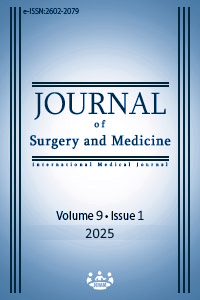A case of brachial artery pseudoaneurysm requiring endovascular therapy twice
Recurrence of brachial artery pseudoaneurysm
Keywords:
Pseudoaneurysm, Balloon tamponade, Stent graft, IVUS, Endovascular therapy, ComplicationAbstract
Brachial artery pseudoaneurysm (BAP) is a complication that can result from trauma, iatrogenic injury, or drug abuse, and can have serious consequences for the limb and overall health, including hemorrhage, nerve injury, venous edema, loss of limb function, and rupture. This paper describes a case of BAP that developed following the first hemostasis procedure and required a second endovascular therapy (EVT) procedure. The patient in this case had an iatrogenic brachial artery pseudoaneurysm (BAP) that appeared 10 days after coronary angiography. The patient experienced swelling and pain in the left upper limb, prompting emergency hemostasis with EVT. Percutaneous thrombin injection was administered, along with balloon inflation, and angiography confirmed successful hemostasis. However, 16 days after the initial EVT, the patient returned to the hospital with the same symptoms, and a recurrence of BAP was observed on duplex ultrasound. Stent graft implantation was required due to vessel structure disruption detected by intravascular ultrasound imaging. Following stent graft deployment, a final angiogram showed that the pseudoaneurysm had disappeared, and the patient experienced no complications for three months. This case highlights the importance of observing vascular structure with intravascular ultrasonography (IVUS) to predict successful hemostasis, and suggests that additional therapy should be considered when the structure is disrupted.
Downloads
References
Yetkin U, Gurbuz A. Post-traumatic pseudoaneurysm of the brachial artery and its surgical treatment. Texas Heart Institute Journal. 2003;30(4):293-7.
Kemp K, Radwan R, Shingler G, Davies C. Brachial artery pseudoaneurysm. BMJ Case Rep. 2014;2014. DOI: https://doi.org/10.1136/bcr-2014-203924
Hayakawa N, Kodera S, Miyauchi A, Hirano S, Sahashi S, Ishibashi N, et al. Effective treatment of iatrogenic femoral pseudoaneurysms by combined endovascular balloon inflation and percutaneous thrombin injection. Cardiovasc Interv Ther. 2022;37(1):158-66. DOI: https://doi.org/10.1007/s12928-021-00764-9
Armstrong PJ, Han DC, Baxter JA, Elmore JR, Franklin DP. Complication rates of percutaneous brachial artery access in peripheral vascular angiography. Annals of Vascular Surgery. 2003;17(1):107-10. DOI: https://doi.org/10.1007/s10016-001-0339-6
Tisi PV, Callam MJ. Treatment for femoral pseudoaneurysms. The Cochrane database of systematic reviews. 2013(11):CD004981. DOI: https://doi.org/10.1002/14651858.CD004981.pub4
Downloads
- 374 520
Published
Issue
Section
How to Cite
License
Copyright (c) 2025 Eiji Koyama, Kazuki Tobita, Hirokazu Miyashita, Shigeru Saito
This work is licensed under a Creative Commons Attribution-NonCommercial-NoDerivatives 4.0 International License.
















